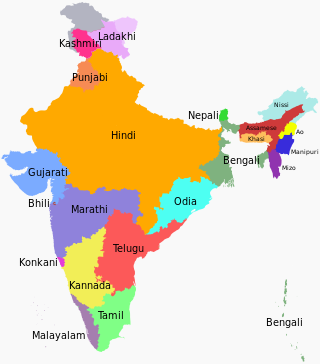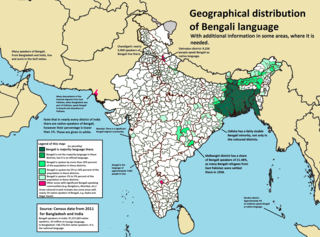
The Brahmic scripts, also known as Indic scripts, are a family of abugida writing systems. They are used throughout the Indian subcontinent, Southeast Asia and parts of East Asia. They are descended from the Brahmi script of ancient India and are used by various languages in several language families in South, East and Southeast Asia: Indo-Aryan, Dravidian, Tibeto-Burman, Mongolic, Austroasiatic, Austronesian, and Tai. They were also the source of the dictionary order (gojūon) of Japanese kana.

Languages spoken in the Republic of India belong to several language families, the major ones being the Indo-Aryan languages spoken by 78.05% of Indians and the Dravidian languages spoken by 19.64% of Indians; both families together are sometimes known as Indic languages. Languages spoken by the remaining 2.31% of the population belong to the Austroasiatic, Sino–Tibetan, Tai–Kadai, and a few other minor language families and isolates. According to the People's Linguistic Survey of India, India has the second highest number of languages (780), after Papua New Guinea (840). Ethnologue lists a lower number of 456.

There is no national language in the Republic of India. However, article 343(1) of the Indian constitution specifically mentions that "The official language of the Union shall be Hindi in Devanagari script. The form of numerals to be used for the official purposes of the Union shall be the international form of Indian numerals," while article 343(2) allowed for the continuation of English as an official language for another 15 years and 343(3) gave the parliament the power to provide for the use of English language after this period. The clause 3 of the Official Languages Act, 1963 allows for the continued use of English language for official purposes of the Union government and for parliamentary business. Hence Indian English and Modern Standard Hindi are the Official Languages of the Government of India.

Meitei, officially known as Manipuri, is a Tibeto-Burman language of northeast India. It is the official language and the lingua franca of Manipur, as well as one of the 22 official languages of the Indian Republic, included in the 8th Schedule to the Indian Constitution. It is one of the advanced literary languages, recognised by Sahitya Akademi, India's National Academy of Letters. It serves as one of the recognised educational and literary languages in Assam and Tripura. Native to the Meitei people, it has around 3 million total speakers, and is used as L1 by around 1.8 million people, predominantly in the state of Manipur, and as L2 by different ethnic groups, in different parts of India, Myanmar and Bangladesh. It was used as a court language in the historic Manipur Kingdom, in accordance to the Manipur State Constitution Act 1947.

The Assamese alphabet is a writing system of the Assamese language and is a part of the Bengali-Assamese script. This script was also used in Assam and nearby regions for Sanskrit as well as other languages such as Bodo, Khasi, Mising, Jaintia etc. It evolved from Kamarupi script. The current form of the script has seen continuous development from the 5th-century Umachal/Nagajari-Khanikargaon rock inscriptions written in an eastern variety of the Gupta script, adopting significant traits from the Siddhaṃ script in the 7th century. By the 17th century three styles of Assamese alphabets could be identified that converged to the standard script following typesetting required for printing. The present standard is identical to the Bengali alphabet except for two letters, ৰ (ro) and ৱ (vo); and the letter ক্ষ (khya) has evolved into an individual consonant by itself with its own phonetic quality whereas in the Bengali alphabet it is a conjunct of two letters.

Bishnupriya Manipuri, also known as Bishnupriya Meitei or simply as Bishnupriya, is an Indo-Aryan lect belonging to the Bengali–Assamese linguistic sub-branch. It is a creole of Bengali language and Meitei language and it still retains its pre-Bengali features. It is spoken in parts of the Indian states of Assam, Tripura and Manipur as well as in the Sylhet Division of Bangladesh. It uses the Bengali-Assamese script as its writing system. Bishnupriya Manipuri, being a member of the Eastern Indo-Aryan languages, was evolved from Magadhi Prakrit. So, its origin is associated with Magadha realm. The Government of Tripura categorised Bishnnupriya Manipuri under the "Tribal Language Cell" of the State Council of Educational Research and Training. Its speakers are also given the "Other Backward Classes" status by the Assam Government and notably, there is no legal status of the Bishnupriyas in Manipur. In the 2020s, the Bishnupriya speaking people started demanding that the Assam Government should give them the status of “indigenous people” of Assam and treat the same like other indigenous communities of the state.
Sylheti Nagri or Sylheti Nagari, known in classical manuscripts as Sylhet Nagri amongst many other names, was an Indic script of the Brahmic family. The script was historically used in areas of Bengal and Assam that were east of the Padma, primarily in the eastern part of the Sylhet region, to document Muslim religious poetry known as puthis; having no presence in formal documentations. In the course of the 20th century, it has lost much ground to the standardised Eastern Nagari script. Printing presses for Sylheti Nagri existed as late as into the 1970s, and in the 2000s, a Unicode font was created for the script.

Boro, also rendered Bodo, is a Sino-Tibetan language spoken primarily by the Boros of Northeast India and the neighboring nations of Nepal and Bangladesh. It is an official language of the Indian state of Assam, predominantly spoken in the Bodoland Territorial Region. It is also one of the twenty-two languages listed in the Eighth Schedule of the Constitution of India. Since 1975 the language has been written using the Devanagari script. It was formerly written using Latin and Eastern-Nagari scripts. Some scholars have suggested that the language used to have its own now lost script known as Deodhai.

The Meitei script, also known as the Meetei script, is an abugida used for the Meitei language, the official language of Manipur state and one of the 22 official languages of India. It is one of the official scripts of the Indian Republic. It is also popularly known as the Kanglei script and the Kok Sam Lai script. Its earliest known evidence of existence dates back to the 6th century AD coins, engraving the Meitei letters, as verified by the various publications of the National Sahitya Akademi. It was used until the 18th century, when it was replaced by the Bengali alphabet. A few manuscripts survive. In the 20th century, the script has experienced a resurgence, and is again being used. Starting from 2021, Meitei script was officially used by the Government of Manipur, along with the Bengali-Assamese script, to write the Meitei language, as per "The Manipur Official Language (Amendment) Act, 2021".

The Tirhuta or Maithili script was the primary historical script for the Maithili language, as well as one of the historical scripts for Sanskrit. It is believed to have originated in the 10th century CE. It is very similar to Bengali–Assamese script, with most consonants being effectively identical in appearance. For the most part, writing in Maithili has switched to the Devanagari script, which is used to write neighbouring Central Indic languages to the west and north such as Hindi and Nepali, and the number of people with a working knowledge of Tirhuta has dropped considerably in recent years.
Romanisation of Bengali is the representation of written Bengali language in the Latin script. Various romanisation systems for Bengali are used, most of which do not perfectly represent Bengali pronunciation. While different standards for romanisation have been proposed for Bengali, none has been adopted with the same degree of uniformity as Japanese or Sanskrit.
Mal Paharia is a language spoken by 51,000 of 110,000 ethnic Mal Paharia in the states of Jharkhand and West Bengal in India, and regions of Bangladesh. The language is also known as Mal Pahoria, Malto, Malti, Paharia, Parsi, and Mal Pahariya. It has been variously regarded as a Bengali–Assamese language, a dialect of Malto, and a mixed Dravidian–Indo-Aryan language. There is a generally positive attitude among speakers of the language towards it, but it is considered vulnerable as some speakers have shifted to Bengali. Mal Paharia uses the Devanagari script and rules for its writing, reading, and speech.

Bengali, generally known by its endonym Bangla, is an Indo-Aryan language native to the Bengal region of South Asia. With approximately 234 million native speakers and another 39 million as second language speakers as of 2017, Bengali is the sixth most spoken native language and the seventh most spoken language by the total number of speakers in the world. Bengali is the fifth most spoken Indo-European language.

The Bengali script or Bangla alphabet is the alphabet used to write the Bengali language based on the Bengali-Assamese script, and has historically been used to write Sanskrit within Bengal. It is one of the most widely adopted writing systems in the world . It is one of the official scripts of the Indian Republic. It is used as the official script of Bengali language in Bangladesh, West Bengal Tripura and Barak valley of Assam as well as Meitei language in Manipur, two of the official languages of India.

The Bengali–Assamese script, also known as Eastern Nagari, is a modern eastern Indic script that emerged from the Brahmi script. Gaudi script is considered the ancestor of the script. It is known as Bengali script among Bengali speakers, as Assamese script among Assamese speakers, and Eastern-Nāgarī is used in academic discourse.

The Assam Higher Secondary Education Council (AHSEC) is a state education regulatory board under the jurisdiction of Ministry of Education, Government of Assam that is responsible to regulate, supervise and develop the system of Higher Secondary Education in the State of Assam.

The Eighth Schedule to the Constitution of India lists the official languages of the Republic of India. At the time when the Constitution was enacted, inclusion in this list meant that the language was entitled to representation on the Official Languages Commission, and that the language would be one of the bases that would be drawn upon to enrich Hindi and English, the official languages of the Union. The list has since, however, acquired further significance. The Government of India is now under an obligation to take measures for the development of these languages, such that "they grow rapidly in richness and become effective means of communicating modern knowledge." In addition, candidates sitting for an examination conducted for public service are entitled to use any of these languages as a medium to answer the paper.

Meitei input methods are the methods that allow users of computers to input texts in the Meitei script, systematically for Meitei language.

The official scripts of the 22 official languages of the Republic of India include abugidas (pseudo-alphabets), alphabetical writing systems and abjads.
Meitei language, the sole official language and the lingua franca of Manipur, one of the scheduled languages of India, one of the recognised educational and literary languages of Assam and Tripura states, has its speakers spread across entire India.
















